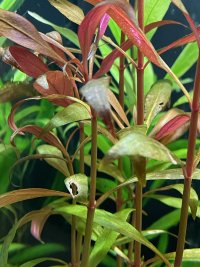misterbiscuit
New Member
I'm new here (hello 🙂), so apologies if I've posted this question in the wrong forum.
I've had my aquarium set up with real plants for quite a few months now, and things have been growing nicely and at a good speed.
However in the past few weeks I've started to notice some plants developing little black spots on them (at first I thought it was just some waste), but then it seems those little black spots turn in to actual small holes through the leaves.
I've been dosing fertilizer each week. I use TNC Lite as it seemed to get positive things said about it, and I went for the 'Lite' version as my tap water already has plenty of nitrates.
From what I've learnt so far there is some sort of deficiency in my water causing this to happen.
I was hoping for some advice on what I can do to fix it, as in should I dose more than I have been of TNC Lite, switch to a different fertilizer or do I need to do something else?


I've had my aquarium set up with real plants for quite a few months now, and things have been growing nicely and at a good speed.
However in the past few weeks I've started to notice some plants developing little black spots on them (at first I thought it was just some waste), but then it seems those little black spots turn in to actual small holes through the leaves.
I've been dosing fertilizer each week. I use TNC Lite as it seemed to get positive things said about it, and I went for the 'Lite' version as my tap water already has plenty of nitrates.
From what I've learnt so far there is some sort of deficiency in my water causing this to happen.
I was hoping for some advice on what I can do to fix it, as in should I dose more than I have been of TNC Lite, switch to a different fertilizer or do I need to do something else?








